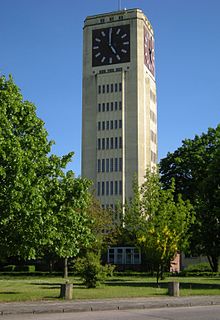Clock tower sewing machine factory (Wittenberge)
The clock tower of the former sewing machine factory Singer / Veritas in Wittenberge is the largest free-standing clock tower on the European mainland. The architectural forms of the yellow plastered tower reveal an influence of Expressionism and above all the New Building .
history
The reason for the construction of the tower was the erection of water tanks to supply the growing sewing machine factory with process water and for fire protection. From this necessity, the architect created a building that is still the symbol of the city of Wittenberge today.
The German Singer AG began construction in March 1928, and the total construction time was 14 months. The total weight of the structure is 5000 tons, 210,000 bricks, 1600 m³ gravel, 13,000 bags of cement and 105 tons of round steel were used for this. The Hamburg construction company Paul Thiele AG was responsible for the design, construction and construction, while the architectural design was carried out by Hamburg architect Felix Ascher .
In the last days of the Second World War , the clock tower was damaged and therefore subsequently decommissioned. Fitters from the tower clock factory Bernhard Zachariä in Leipzig carried out the first repairs in 1956: On June 20, 1957 the tower shone again, the clock showed the time. In 1988 the tower clocks were completely overhauled , again by the Leipzig special watch company.
Watch technology
The clock tower has four tower clock movements: for each of the four dials there is an independent drive mechanism with a small three-phase motor. These run as ancillary works and until 1994 were controlled by a master clock with a weight drive, electric elevator and a precision pendulum. On September 9, 1994, the radio age began for "celebrities"; since then it has been controlled by the atomic clock of the Physikalisch-Technische Bundesanstalt in Braunschweig. Radio impulses set the small electric motors in motion and, thanks to a large gear ratio, turn the clockwork one minute further. Curiously, however, this state-of-the-art control did not work with the clock - the clock advanced for the first time in over 65 years.
Since August 2007 clockwork malfunctions are a thing of the past. The reason why the clocks operated was that each clockwork was controlled by a micro switch with two switching states (scanned by the minute via a toothed disk). The overrun of the motors sometimes caused the clockwork to run beyond a switching state (the following minute). Accordingly, the movement in question then advanced two minutes. Now every movement is controlled by small electronics, connected to a fork light barrier and a segment disc. As a result, the running of the engines is no longer a problem. In addition, mechanical wear no longer plays a role, since the micro buttons are no longer required.
The clock tower can be visited from May to the end of September. The opening times and dates for guided tours are published on the city's website.
Data
- Year of construction: 1928/1929
- Tower height: 49.40 m
- Levels: 192
- Tower width: 11.30 m × 11.30 m
- Dial diameter: 7.57 m (illuminated)
- Pointer: 3.30 m and 2.25 m (illuminated)
- Digit height: 1.00 m × 0.40 m (illuminated)
The tower clock has four dials (one in each direction ); thanks to the nighttime lighting, the time can be read from a distance of up to twelve kilometers.
Web links
Coordinates: 52 ° 59 ′ 27.9 ″ N , 11 ° 46 ′ 6.1 ″ E

